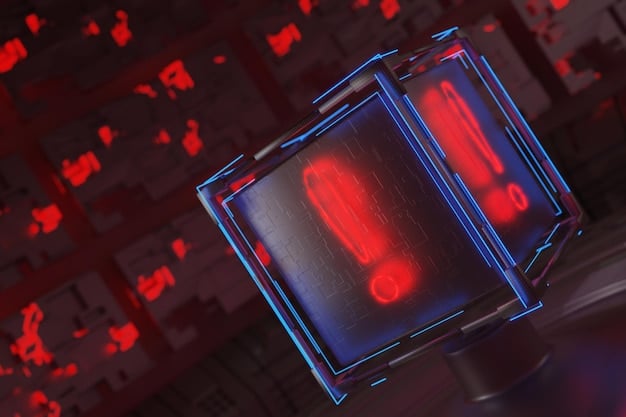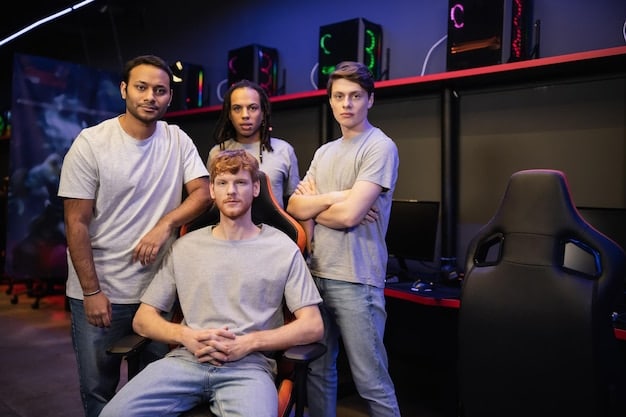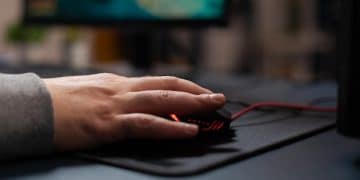New Anti-Cheating Measures in US Esports: What to Expect Next 6 Months

Over the next six months, US esports tournaments are poised to implement a suite of advanced anti-cheating measures, encompassing enhanced AI-driven anomaly detection, more rigorous hardware and software integrity checks, and collaborative intelligence sharing among organizers to safeguard competitive fairness and player trust.
As the competitive landscape of esports continues its meteoric rise, maintaining fair play rests on robust anti-cheating protocols. The question on everyone’s minds is: What are the New Anti-Cheating Measures Being Implemented in US Esports Tournaments in the Next 6 Months? This article delves into the strategies and technologies set to redefine integrity in competitive gaming, moving beyond traditional methods to embrace a more proactive and sophisticated approach.
The Escalating Cheating Landscape in Esports
The allure of competitive esports, with its burgeoning prize pools, sponsorship deals, and global fan base, has regrettably amplified the motivations for cheating. From aimbots to map hacks, illicit software provides an unfair advantage, undermining the very essence of fair competition and eroding spectator trust. The scale and sophistication of these tools are evolving at an alarming pace, forcing tournament organizers to constantly adapt their defenses.
Traditional anti-cheating methods, while foundational, often prove reactive or easily circumvented by determined cheaters. These older systems typically rely on signature-based detection, which identifies known cheating programs. However, this approach struggles against novel or custom-built cheats, allowing a window of opportunity for illicit activity before detection and subsequent blacklisting. The arms race between cheaters and anti-cheat developers is perpetual, demanding more dynamic and predictive solutions.
The Rise of Sophisticated Cheats
Modern cheats are no longer simple toggles; they often integrate complex programming designed to evade detection. For instance, some cheats use polymorphic code that constantly changes its signature, making it difficult for traditional anti-cheat systems to recognize. Others operate at a kernel level, deeply embedded within the operating system, making them incredibly hard to detect without intrusive measures that could raise privacy concerns. This constant innovation on the cheating front necessitates equally innovative defensive strategies.
- Behavioral pattern analysis: Identifying unusual player actions.
- Hardware-level integrity checks: Verifying device authenticity.
- Rootkit detection: Uncovering deeply embedded malicious software.
The financial incentives in professional esports championships are significant, turning cheating into a high-stakes, high-reward proposition for unethical players. The reputation of entire leagues and the value of sponsoring brands are at stake, making investments in robust anti-cheating infrastructure a paramount concern. This economic pressure is a primary driver behind the rapid adoption of new, stringent measures.
Moreover, the community aspect of esports plays a crucial role. When viewers perceive a lack of integrity, their engagement wanes, directly impacting viewership numbers and the ecosystem’s overall health. Ensuring a fair playing field is not just about rules; it’s about preserving the passion and dedication that define the esports community.
Advanced AI and Machine Learning for Anomaly Detection
One of the most significant advancements foreseen in the next six months involves the expanded deployment of Artificial Intelligence (AI) and Machine Learning (ML) algorithms. These systems are moving beyond simple signature matching to analyze vast datasets of player behavior, identifying anomalies that suggest foul play. Unlike human observers, AI can process thousands of data points concurrently, detecting nuanced patterns invisible to the naked eye.
AI-driven anti-cheat systems develop sophisticated profiles of legitimate player behavior. They learn what normal aiming, movement, and reaction times look like for players across various skill tiers. When a player deviates significantly from these learned norms—perhaps with unnaturally perfect aim transfers, impossible reaction times, or through-wall targeting—the AI flags this as suspicious, initiating further investigation. This proactive approach significantly reduces response times.

Predictive Modeling and Real-Time Analysis
ML models are increasingly capable of predictive analysis, identifying potential cheaters even before they use a widely known exploit. By observing subtle pre-cheating behaviors or unusual software interactions, ML can generate alerts for human reviewers. Real-time analysis is also becoming more prevalent, allowing for immediate intervention rather than post-match reviews, which can disrupt tournament flow and integrity.
- Behavioral profiling against established baselines.
- Detection of unusual input data consistent with automation.
- Machine learning models identifying new cheat patterns.
The true power of AI in anti-cheating lies in its adaptability. As cheaters refine their methods, AI systems can continually learn and update their detection algorithms without requiring manual updates from developers. This adaptive learning capability creates a formidable defense, making it harder for new cheats to remain undetected for long periods. The continuous feedback loop ensures that the anti-cheat system grows smarter with every new piece of data it processes.
However, implementing AI/ML is not without its challenges. False positives, where legitimate players are wrongly accused, are a major concern. Developers are working on refining these algorithms to minimize such occurrences, often by incorporating human oversight into the final decision-making process. The goal is to strike a balance between aggressive detection and fair, accurate adjudication.
Enhanced Hardware and Software Integrity Checks
Beyond behavioral analysis, a critical layer of defense comes from rigorously monitoring and verifying the hardware and software environments of professional players. Tournament organizers are poised to implement more invasive, yet necessary, checks to ensure that no unauthorized modifications are made to gaming setups. This includes everything from peripherals to operating system configurations.
New measures might involve pre-tournament hardware inspections, mandatory use of standardized, organization-provided equipment, or even the implementation of “locked down” operating systems. These systems would prevent the installation of non-approved software or background processes, thereby eliminating many conventional avenues for cheating. The objective is to create a controlled environment where the only variable is player skill.
Kernel-Level Anti-Cheats and Secure Boot
Kernel-level anti-cheat solutions, which operate at the deepest layers of a computer’s operating system, are likely to see wider adoption. While controversial due to potential privacy implications, these systems offer unparalleled insight into a computer’s processes, making them highly effective at detecting sophisticated cheats that hide from user-mode anti-cheats. Alongside these, technologies like Secure Boot, which ensures only trusted software loads at startup, are becoming standard.
- Mandatory device checks before competitive play.
- Use of whitelisted applications and operating system configurations.
- Real-time monitoring of system processes during matches.
The increasing use of specialized, locked-down tournament client software is another significant trend. These clients strip away non-essential functionalities and are designed with robust tamper-detection mechanisms built in. Players connect to dedicated, secure servers that log every input and output, making it easier to review suspicious activity retrospectively.
While these measures significantly enhance security, they often come with logistical challenges and require cooperation from players. Educating players about the necessity of these integrity checks and ensuring transparent processes are crucial for successful implementation. The long-term benefit of a fair competitive environment usually outweighs the short-term inconvenience for legitimate players.
Collaborative Intelligence Sharing and Blacklisting
The fight against cheating is not a solitary battle. Recognizing this, a major development over the next six months will be an increase in intelligence sharing and collaboration among different tournament organizers, game developers, and anti-cheat providers. This unified front aims to create a more comprehensive and proactive defense against cheaters.
Currently, information about newly discovered cheats or identified cheaters can be siloed within individual organizations. This allows cheaters to potentially move between different games or leagues, exploiting the gap in shared knowledge. A collaborative approach would mean rapid dissemination of threat intelligence, allowing all involved parties to update their defenses simultaneously.
Cross-Platform Cheater Databases
The establishment of a shared, cross-platform database of identified cheaters and cheat methods is highly probable. This could involve a centralized system where information on bans and suspicious patterns is anonymized and shared. Such a system would make it significantly harder for cheaters to simply rebrand or move to a different tournament after being caught in one.
- Timely sharing of new cheat exploits among organizations.
- Building a centralized database of known cheaters.
- Joint research and development of anti-cheat technologies.
This collaborative framework extends beyond just sharing data; it also involves joint research and development efforts. By pooling resources and expertise, anti-cheat technology can evolve faster and more efficiently. Regular summits or working groups among key stakeholders could facilitate this knowledge exchange, leading to more robust and unified solutions across the entire esports ecosystem.
The major hurdle for such collaboration is often proprietary concerns and competitive advantage. However, the shared threat of cheating is so significant that the benefits of collaboration are starting to outweigh these individual concerns. A cleaner esports environment ultimately benefits everyone involved, from players and teams to viewers and sponsors.
Player Education, Reporting, and Whistleblower Programs
While technological solutions are paramount, the human element remains vital in the fight against cheating. Over the next six months, there will be increased emphasis on educating players about fair play, improving reporting mechanisms, and potentially establishing more robust whistleblower programs to encourage ethical conduct from within the community.
Tournament organizers will intensify efforts to clearly communicate their anti-cheating policies, the consequences of violations, and the ethical responsibilities of professional players. This proactive education can deter some individuals and foster a stronger culture of integrity. Clear guidelines also help players understand the expectations placed upon them.
Streamlined Reporting Systems
Making it easier and more anonymous for players and spectators to report suspicious activity is crucial. This could involve simplified in-game reporting tools that capture relevant data automatically, or dedicated channels for anonymous tips. When reporting is cumbersome or perceived as futile, potential intelligence is lost. Streamlining this process empowers the community to contribute to integrity.
- Clear communication of anti-cheating policies.
- User-friendly tools for reporting suspicious activity.
- Incentivized or protected whistleblower channels.
Whistleblower programs, particularly in team-based games, could offer a powerful deterrent. Providing mechanisms for players to report teammates or competitors who they suspect are cheating, with assurances of anonymity and protection from retaliation, can uncover issues that technology alone might miss. Such programs require careful implementation to prevent abuse, but their potential impact is significant.

Fostering a culture where cheating is not tolerated, and where integrity is celebrated, is a long-term goal. These human-centric measures complement the technological advancements, creating a multi-faceted defense. The combination of strong technological enforcement and a committed, ethical community creates the most formidable barrier against cheating in esports.
Legal and Enforcement Frameworks Strengthening
Beyond in-game measures, the legal and contractual frameworks surrounding esports tournaments are being strengthened. This includes more explicit clauses in player contracts regarding anti-cheating, stricter penalties, and potentially even legal recourse against severe and repeated offenders. The aim is to create a stronger legal deterrence against illicit activities.
Player contracts are expected to include more detailed and stringent clauses related to anti-cheat compliance. These clauses will spell out the consequences of cheating, ranging from immediate disqualification and prize forfeiture to lengthy suspensions and permanent bans from all affiliated competitions. Such contractual obligations provide a clear legal basis for enforcement.
Increased Penalties and Legal Recourse
The financial and reputational losses for cheaters are set to increase. Not only will prize money be clawed back, but there could be provisions for seeking damages for harm to tournament reputation or sponsor relationships. Furthermore, in cases of severe and organized cheating, legal action beyond the contractual realm might be pursued, depending on the jurisdiction and explicit agreements.
- Explicit anti-cheating clauses in player contracts.
- Severe financial penalties and long-term bans.
- Potential for legal action against cheaters or cheat providers.
The rising value of esports means that intellectual property protections and terms of service agreements are also gaining more legal weight. Developers of anti-cheat software and game publishers are increasingly likely to pursue legal action against creators and distributors of cheating software, aiming to cut off the supply chain for illicit tools. This approach tackles the problem at its source rather than solely focusing on the end-user.
While legal routes can be slow and expensive, their existence serves as a powerful deterrent. The specter of formal legal consequences adds a new dimension to anti-cheating efforts, signaling that competitive integrity is a non-negotiable principle within the esports industry. It underscores a shift towards treating cheating as a serious professional transgression, not merely a game infraction.
Challenges and Ethical Considerations Ahead
The implementation of advanced anti-cheating measures, while necessary, is not without its challenges and ethical considerations. Balancing effectiveness with player privacy, ensuring equitable application of rules, and adapting to the ever-evolving landscape of cheating methods are complex issues that require careful navigation.
The deep level of system access required by some kernel-level anti-cheats raises legitimate privacy concerns among players. Organizations must be transparent about what data is collected, how it’s used, and how it’s protected. Building trust through clear communication and robust data security protocols is essential to avoid alienating the player base.
False Positives and Player Trust
No anti-cheat system is perfect, and false positives—where legitimate players are wrongly accused—can severely damage careers and reputations. Developing highly accurate algorithms with minimal false positive rates is a continuous challenge. Furthermore, establishing fair and efficient appeal processes for players who believe they have been wrongly accused is critical to maintaining faith in the system.
- Addressing player privacy concerns with data collection.
- Minimizing false positives in detection algorithms.
- Ensuring equitable application of rules across regions and players.
Another challenge is the global nature of esports and the varied legal frameworks concerning data privacy and digital rights. Implementing a uniform set of anti-cheating measures across different jurisdictions can be legally complex. International collaboration and harmonization of standards will be crucial for effective global enforcement.
Finally, the arms race with cheaters is perpetual. As anti-cheat measures become more sophisticated, so too do the methods of cheating. This ongoing cycle demands constant vigilance, investment in research and development, and a willingness to adapt new technologies and strategies. The goal is not to eliminate cheating entirely, but to make it so difficult and risky that it ceases to be a viable option for aspiring professionals.
| Key Measure | Brief Description |
|---|---|
| 🤖 AI-Driven Detection | Utilizes AI and ML to detect atypical player behavior and new cheat patterns in real-time. |
| 🔒 Hardware/Software Integrity | Enforces stricter checks on gaming setups, including kernel-level anti-cheats and secure boot. |
| 🤝 Collaborative Intelligence | Promotes sharing of cheat data and insights among different tournament organizers. |
| ⚖️ Stronger Legal Frameworks | Enforces explicit contractual clauses and pursues legal action against cheaters and cheat providers. |
Frequently Asked Questions (FAQ)
▼
The increasing financial stakes in esports, coupled with the rapid evolution of sophisticated cheating software, necessitate more robust and proactive anti-cheating measures. Maintaining competitive integrity is crucial for player trust, spectator engagement, and the overall ecosystem’s health, which is being challenged by ever-adapting illicit means.
▼
AI and Machine Learning systems analyze vast amounts of player data, identifying subtle, anomalous behavioral patterns that traditional signature-based methods often miss. They can learn and adapt to new cheat variations in real-time, offering a more dynamic defense than static detection lists, and enable predictive modeling for early warnings of suspicious activity.
▼
Kernel-level anti-cheats operate at the deepest level of a computer’s operating system, providing comprehensive oversight to detect deeply embedded cheats. While highly effective, they raise privacy concerns due to their intrusive nature. Developers are focused on transparency and security to ensure player data is protected and false positives minimized.
▼
For professional tournaments, players may be required to use standardized, organization-provided equipment or participate in events where their gaming setups are subject to rigorous checks. This includes mandatory use of approved software configurations to ensure a level playing field, potentially limiting personal modifications during competitive play.
▼
Players can contribute by adhering to strict ethical standards, utilizing streamlined reporting systems for suspicious activity, and participating in educational programs that promote fair play. Some tournaments may also implement whistleblower programs, allowing anonymous reporting of rule violations, reinforcing community vigilance against cheating behaviors.
Conclusion
The next six months mark a pivotal period for integrity in US esports. The proactive push towards sophisticated anti-cheating measures, encompassing AI-driven detection, stringent hardware and software integrity checks, and unprecedented industry collaboration, signifies a clear commitment to fostering a fair and reputable competitive environment. These advancements, coupled with strengthened legal frameworks and community engagement, are poised to elevate trust and ensure the sustained growth and excitement of competitive gaming, creating a future where skill, not illicit advantage, defines champions.





